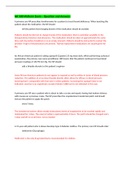Exam (elaborations)
SANS FOR578 QUETIONS AND ANSWERS LATEST UPDATED VERSION guaranteed a+
- Module
- Institution
SANS FOR578 QUETIONS AND ANSWERS LATEST UPDATED VERSION guaranteed a+ s 1. What does the acronym SANS stand for? o A) System and Network Security o B) SysAdmin, Networking, and Security o C) Security and Network Solutions o D) Secure Administration Network System Answer: B Rationale: SANS...
[Show more]












